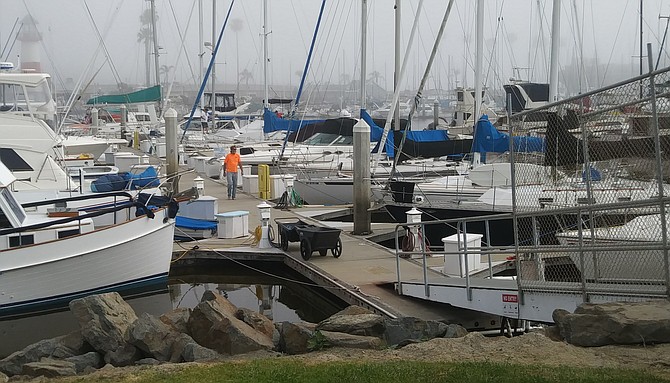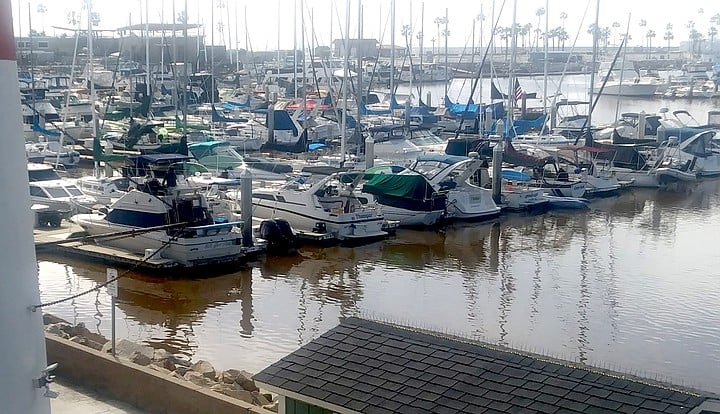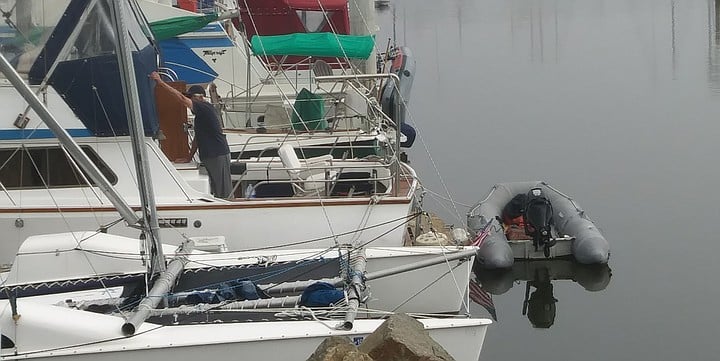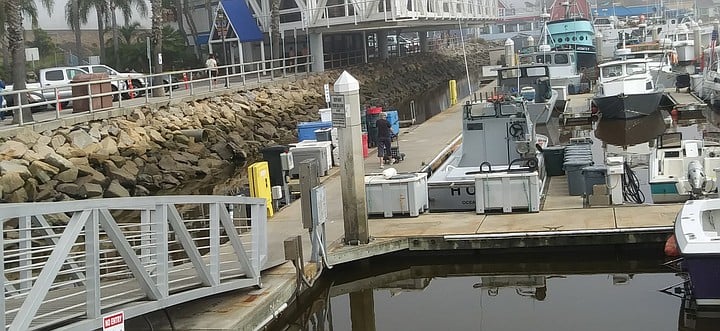 Facebook
Facebook
 X
X
 Instagram
Instagram
 TikTok
TikTok
 Youtube
Youtube

Since Sunday April 26 the water in the Oceanside harbor has taken on a rich brown hue. Although the coffee-colored water looked like it could be a briny fecal stew, harbor fisherman explain that it has nothing to do with a busted sewer main or with toilet flushes from the live-aboards who stay in the harbor year-round.
“This is all because of the red tide,” says Bruce Campbell who has been catching shrimp, lobster, and crab for the last 50 years. It turns out the recent plankton invasion that made for pretty, glow-in-the-dark waves at night, also creates a foul-smelling marina that apparently does not have as much saltwater flushing as it should. “But it normally happens around July 4," says Campbell. "This year with all the fresh water from the rain and the warm weather, I guess it came a little earlier…It sucks up all the oxygen. Pretty soon you’ll probably see [algae] floating in the harbor.”

Longtime locals will tell you the brown harbor water will eventually start to emit a strong stench before it goes away. James Garner catches anchovies and sardines which he sells for live bait through his Oceanside Bait Company. He thinks this may the worst red tide invasion in the harbor in 15 years.
“The last time we had a red tide this bad was in 2005 after we had 27 inches of rain,” says Garner. “When [the plankton] died, it turned to acid and it killed everything in the harbor. You’d see all the starfish and lobster crawl out of the water and crawl up on the rocks to get away from it. That’s like if our air got so bad, we’d crawl into the water. This happens anytime we get a lot of fresh water from the rain followed by a lot of sunshine. It wouldn’t have been so bad this year if we hadn’t gotten that last seven inches in one week.”
Garner says back in 2005 the live bait he caught and kept in the harbor water in containers alongside his boat, “…died and turned into a milky lime green.”

Even in the midst of stinky, toxic harbor waters, and with a zombie-like rock lobster invasion looming, Campbell and Garner still seem bullish about the live bounty still available to them out past the jetty.
But the post COVID-19 rules put into effect April 21 by the city of Oceanside brought to light what some says is a dirty little secret about the Oceanside harbor: that the Oceanside marina, built in 1963 to house recreational pleasure craft, has morphed into a permanent residence for the live-aboards who are using it as a “floating trailer park” according to some who are unhappy with the transformation. According to Oceanside harbor manager Ted Schiafone there are 850 slips for recreational boats and about 85 (ten percent) are rented by those who are given year-round live-aboard status. The other 765 recreational boat owners can stay overnight only up to three nights a week.
Based on rates provided by Schiafone, a live-aboard with a 30-foot boat would pay about $480 a month in basic slip rent and an extra $114 because it is deemed a live-aboard. This would include two adults and potentially a child and a pet. The extra $114 means they get free electricity and water and get to use the harbor’s laundromat and shower facilities.

The county mandated a shutdown of all recreational boating which means all craft in county marinas can not head out to sea. On April 22, Schiafone notified the other 765 slip renters who are not permanent live-aboards that they could visit their craft in the daytime but temporarily not utilize their three-night-a-week sleepover option. “Due to all of the measures in place to prevent the spread of COVID 19, overnight stays are not permitted.” Taking away their three-night-a-week sleepover caused some non-live-aboards to protest to the city.
At an April 22 city council meeting, Councilwoman Esther Sanchez railed against the new temporary restrictions for the 765 non-live-aboards who were told they could not stay overnight. “Folks who are slip renters who have the ability to stay overnight, see them as a second home,” says Sanchez.
One slip renter who is not a live-aboard but who did want to be identified because he has become vocal about this issue, outlined Oceanside’s liberal policy for those who aren't live-aboards. He says in addition to the three-night-a-week sleepover allowance, they are allowed an additional “nine or ten three-night sleepover passes a year….and on top of that, they can buy what they call a hotel pass where they can stay an additional three nights a week for $28.”
The boat owner says that the harbor administration maintains a waiting list for slip renters who want to become one of the 85 who can use their boat as an apartment. “It takes like four to five years to get a permit,” he says. Current live-aboards on the list cannot transfer their live-aboard status to others by sale or by inheritance.
The Oceanside harbor administration uses a “key fob” pass that allows slip renters to open their gates. This pass is supposed to monitor the activity of all slip renters. Some harbor regulars wonder out loud how effective this system is.
“I am not there a lot at night, but what I hear is that there is a lot of people cheating the system,” says bait trader Garner. “I’ve heard it’s been going on for quite some time. They are using all the live-aboard facilities but not paying the live-aboard fees. It’s not fair to the others who live there legally and pay their share.”
Harbor manager Schiafone says his staff does go after Oceanside’s sneaky boat people. “It’s those illegal live-aboards (sometimes called sneak-aboards) that create issues,” he writes. “The Harbor was never designed to handle them living at the Harbor. The electrical system that runs down each dock could never handle the demand. Our on-shore facilities are not built to handle more live-aboards than what are legally permitted. Many vessels are not equipped to live-aboard, such as proper heating, cooking or plumbing for sanitation. That is a huge safety and environmental issue. Illegal live-aboards are stealing a service from the Harbor.”
In order to keep poop and dishwater out of the harbor, Schiafone says all live-aboards are required to have a holding tank on their vessel, and that they can either use a harbor-supplied waste pump, call a service company to pump out the bilge, or take their boat out at least three miles and cast their waste to the sea.
Some marinas do not allow any sleepovers. The closest to Oceanside is the Dana Point Marina 21 miles north. It officially has only 12 slips out of 2400 that are allowed for sleepovers. A lady who answered the phone at Dana Point says the policy there is to phase out all sleepovers. She says that once these grandfathered 12 slip-owners pass, that slip will lose its sleepover status. She says of Dana Point sneak-overs, “We have a lot of those.”
Was Councilwoman Sanchez suggesting that Oceanside should start counting small craft dwelling units as part of Oceanside’s housing element? A written request for comment to Sanchez was not returned.


Since Sunday April 26 the water in the Oceanside harbor has taken on a rich brown hue. Although the coffee-colored water looked like it could be a briny fecal stew, harbor fisherman explain that it has nothing to do with a busted sewer main or with toilet flushes from the live-aboards who stay in the harbor year-round.
“This is all because of the red tide,” says Bruce Campbell who has been catching shrimp, lobster, and crab for the last 50 years. It turns out the recent plankton invasion that made for pretty, glow-in-the-dark waves at night, also creates a foul-smelling marina that apparently does not have as much saltwater flushing as it should. “But it normally happens around July 4," says Campbell. "This year with all the fresh water from the rain and the warm weather, I guess it came a little earlier…It sucks up all the oxygen. Pretty soon you’ll probably see [algae] floating in the harbor.”

Longtime locals will tell you the brown harbor water will eventually start to emit a strong stench before it goes away. James Garner catches anchovies and sardines which he sells for live bait through his Oceanside Bait Company. He thinks this may the worst red tide invasion in the harbor in 15 years.
“The last time we had a red tide this bad was in 2005 after we had 27 inches of rain,” says Garner. “When [the plankton] died, it turned to acid and it killed everything in the harbor. You’d see all the starfish and lobster crawl out of the water and crawl up on the rocks to get away from it. That’s like if our air got so bad, we’d crawl into the water. This happens anytime we get a lot of fresh water from the rain followed by a lot of sunshine. It wouldn’t have been so bad this year if we hadn’t gotten that last seven inches in one week.”
Garner says back in 2005 the live bait he caught and kept in the harbor water in containers alongside his boat, “…died and turned into a milky lime green.”

Even in the midst of stinky, toxic harbor waters, and with a zombie-like rock lobster invasion looming, Campbell and Garner still seem bullish about the live bounty still available to them out past the jetty.
But the post COVID-19 rules put into effect April 21 by the city of Oceanside brought to light what some says is a dirty little secret about the Oceanside harbor: that the Oceanside marina, built in 1963 to house recreational pleasure craft, has morphed into a permanent residence for the live-aboards who are using it as a “floating trailer park” according to some who are unhappy with the transformation. According to Oceanside harbor manager Ted Schiafone there are 850 slips for recreational boats and about 85 (ten percent) are rented by those who are given year-round live-aboard status. The other 765 recreational boat owners can stay overnight only up to three nights a week.
Based on rates provided by Schiafone, a live-aboard with a 30-foot boat would pay about $480 a month in basic slip rent and an extra $114 because it is deemed a live-aboard. This would include two adults and potentially a child and a pet. The extra $114 means they get free electricity and water and get to use the harbor’s laundromat and shower facilities.

The county mandated a shutdown of all recreational boating which means all craft in county marinas can not head out to sea. On April 22, Schiafone notified the other 765 slip renters who are not permanent live-aboards that they could visit their craft in the daytime but temporarily not utilize their three-night-a-week sleepover option. “Due to all of the measures in place to prevent the spread of COVID 19, overnight stays are not permitted.” Taking away their three-night-a-week sleepover caused some non-live-aboards to protest to the city.
At an April 22 city council meeting, Councilwoman Esther Sanchez railed against the new temporary restrictions for the 765 non-live-aboards who were told they could not stay overnight. “Folks who are slip renters who have the ability to stay overnight, see them as a second home,” says Sanchez.
One slip renter who is not a live-aboard but who did want to be identified because he has become vocal about this issue, outlined Oceanside’s liberal policy for those who aren't live-aboards. He says in addition to the three-night-a-week sleepover allowance, they are allowed an additional “nine or ten three-night sleepover passes a year….and on top of that, they can buy what they call a hotel pass where they can stay an additional three nights a week for $28.”
The boat owner says that the harbor administration maintains a waiting list for slip renters who want to become one of the 85 who can use their boat as an apartment. “It takes like four to five years to get a permit,” he says. Current live-aboards on the list cannot transfer their live-aboard status to others by sale or by inheritance.
The Oceanside harbor administration uses a “key fob” pass that allows slip renters to open their gates. This pass is supposed to monitor the activity of all slip renters. Some harbor regulars wonder out loud how effective this system is.
“I am not there a lot at night, but what I hear is that there is a lot of people cheating the system,” says bait trader Garner. “I’ve heard it’s been going on for quite some time. They are using all the live-aboard facilities but not paying the live-aboard fees. It’s not fair to the others who live there legally and pay their share.”
Harbor manager Schiafone says his staff does go after Oceanside’s sneaky boat people. “It’s those illegal live-aboards (sometimes called sneak-aboards) that create issues,” he writes. “The Harbor was never designed to handle them living at the Harbor. The electrical system that runs down each dock could never handle the demand. Our on-shore facilities are not built to handle more live-aboards than what are legally permitted. Many vessels are not equipped to live-aboard, such as proper heating, cooking or plumbing for sanitation. That is a huge safety and environmental issue. Illegal live-aboards are stealing a service from the Harbor.”
In order to keep poop and dishwater out of the harbor, Schiafone says all live-aboards are required to have a holding tank on their vessel, and that they can either use a harbor-supplied waste pump, call a service company to pump out the bilge, or take their boat out at least three miles and cast their waste to the sea.
Some marinas do not allow any sleepovers. The closest to Oceanside is the Dana Point Marina 21 miles north. It officially has only 12 slips out of 2400 that are allowed for sleepovers. A lady who answered the phone at Dana Point says the policy there is to phase out all sleepovers. She says that once these grandfathered 12 slip-owners pass, that slip will lose its sleepover status. She says of Dana Point sneak-overs, “We have a lot of those.”
Was Councilwoman Sanchez suggesting that Oceanside should start counting small craft dwelling units as part of Oceanside’s housing element? A written request for comment to Sanchez was not returned.
Comments